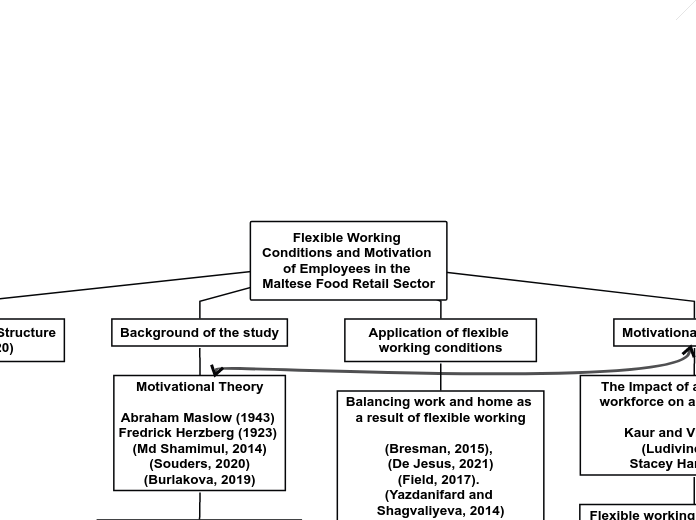Flexible Working Conditions and Motivation of Employees in the Maltese Food Retail Sector
Introduction of Structure
PWC (2020)
Background of the study
Motivational Theory
Abraham Maslow (1943)
Fredrick Herzberg (1923)
(Md Shamimul, 2014)
(Souders, 2020)
(Burlakova, 2019)
Defining flexible working conditions
(Kröl and Nüesch, 2017).
(Delle-Vergini, 2017)
(Masuda et al, 2012, p.3).
(Wickramasinghe et al, 2019)
(Riyanto, 2020).
(Sobia and Madiha, 2018).
(Ivanauskaitė, 2015
(Kamerāde et al, 2019)
(Henderson, 2014)
(König, 2016).
Application of flexible working conditions
Balancing work and home as a result of flexible working
(Bresman, 2015),
(De Jesus, 2021)
(Field, 2017).
(Yazdanifard and Shagvaliyeva, 2014)
(Giovanis, 2017
(Ellen, 2015)
(Eleanor, 2017)
(Allen, Johnson, Kibruz and Shockley, 2015)
(Omondi, 2018)
(Szende, Bagnera and Cole, 2020).
Flexible working conditions in the retail sector
(Eurofound, 2016)
(Newsome and Cunningham, 2017).
(Amato-McCoy, 2017)
(Food Retailers in Europe and worldwide, 2018).
(Taylor, 2019),
(René Vader, 2020).
Organisational culture and its impact on flexible working conditions
(Kummerow & Kirby, 2014).
(Agarwala, Arizkuren and Castillo, 2017)
(Field, 2017)
(Timms, 2014)
Motivational Concepts
The Impact of a demotivated workforce on an organisation
Kaur and Vijay (2016)
(Ludivine, 2011)
Stacey Harris (2013)
Flexible working conditions and their use as motivational tools during covid-19
(Bienstock and La Perla, 2020).
(Ahrendt, Cabrita and Clerici , 2020)
Issue
Angle No.1
Point of view
Type of narration
Angle No.2
Point of view
Type of narration
Subtopic
Angle No.3
Point of view
Type of narration
Angle No.4
Point of view
Type of narration
